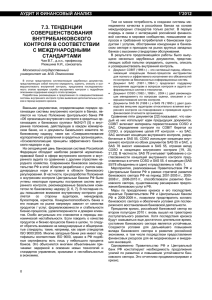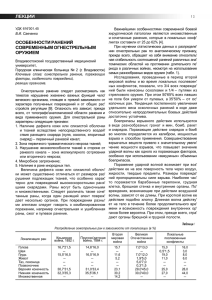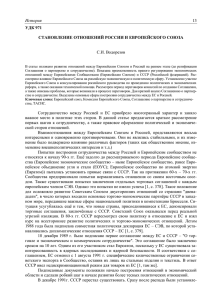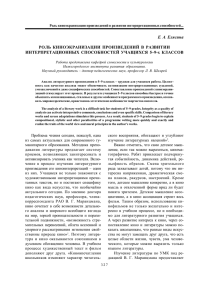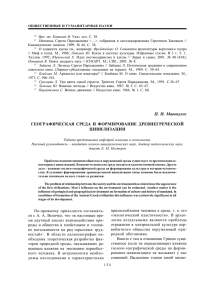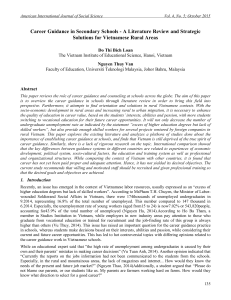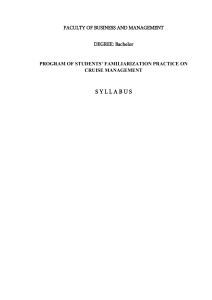ВИКОРИСТАНА ЛІТЕРАТУРА
реклама
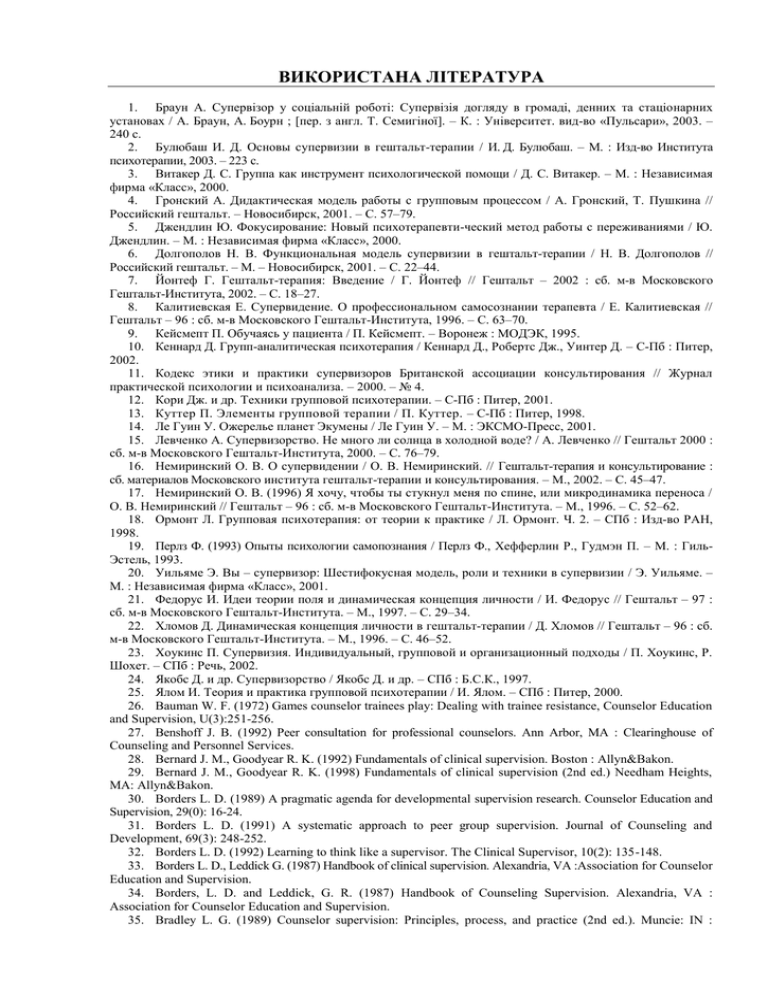
ВИКОРИСТАНА ЛІТЕРАТУРА 1. Браун А. Супервізор у соціальній роботі: Супервізія догляду в громаді, денних та стаціонарних установах / А. Браун, А. Боурн ; [пер. з англ. Т. Семигіної]. – К. : Університет. вид-во «Пульсари», 2003. – 240 с. 2. Булюбаш И. Д. Основы супервизии в гештальт-терапии / И. Д. Булюбаш. – М. : Изд-во Института психотерапии, 2003. – 223 с. 3. Витакер Д. С. Группа как инструмент психологической помощи / Д. С. Витакер. – М. : Независимая фирма «Класс», 2000. 4. Гронский А. Дидактическая модель работы с групповым процессом / А. Гронский, Т. Пушкина // Российский гештальт. – Новосибирск, 2001. – С. 57–79. 5. Джендлин Ю. Фокусирование: Новый психотерапевти-ческий метод работы с переживаниями / Ю. Джендлин. – М. : Независимая фирма «Класс», 2000. 6. Долгополов Н. В. Функциональная модель супервизии в гештальт-терапии / Н. В. Долгополов // Российский гештальт. – М. – Новосибирск, 2001. – С. 22–44. 7. Йонтеф Г. Гештальт-терапия: Введение / Г. Йонтеф // Гештальт – 2002 : сб. м-в Московского Гештальт-Института, 2002. – С. 18–27. 8. Калитиевская Е. Супервидение. О профессиональном самосознании терапевта / Е. Калитиевская // Гештальт – 96 : сб. м-в Московского Гештальт-Института, 1996. – С. 63–70. 9. Кейсмепт П. Обучаясь у пациента / П. Кейсмепт. – Воронеж : МОДЭК, 1995. 10. Кеннард Д. Групп-аналитическая психотерапия / Кеннард Д., Робертс Дж., Уинтер Д. – С-Пб : Питер, 2002. 11. Кодекс этики и практики супервизоров Британской ассоциации консультирования // Журнал практической психологии и психоанализа. – 2000. – № 4. 12. Кори Дж. и др. Техники групповой психотерапии. – С-Пб : Питер, 2001. 13. Куттер П. Элементы групповой терапии / П. Куттер. – С-Пб : Питер, 1998. 14. Ле Гуин У. Ожерелье планет Экумены / Ле Гуин У. – М. : ЭКСМО-Пресс, 2001. 15. Левченко А. Супервизорство. Не много ли солнца в холодной воде? / А. Левченко // Гештальт 2000 : сб. м-в Московского Гештальт-Института, 2000. – С. 76–79. 16. Немиринский О. В. О супервидении / О. В. Немиринский. // Гештальт-терапия и консультирование : сб. материалов Московского института гештальт-терапии и консультирования. – М., 2002. – С. 45–47. 17. Немиринский О. В. (1996) Я хочу, чтобы ты стукнул меня по спине, или микродинамика переноса / О. В. Немиринский // Гештальт – 96 : сб. м-в Московского Гештальт-Института. – М., 1996. – С. 52–62. 18. Ормонт Л. Групповая психотерапия: от теории к практике / Л. Ормонт. Ч. 2. – СПб : Изд-во РАН, 1998. 19. Перлз Ф. (1993) Опыты психологии самопознания / Перлз Ф., Хефферлин Р., Гудмэн П. – М. : ГильЭстель, 1993. 20. Уильяме Э. Вы – супервизор: Шестифокусная модель, роли и техники в супервизии / Э. Уильяме. – М. : Независимая фирма «Класс», 2001. 21. Федорус И. Идеи теории поля и динамическая концепция личности / И. Федорус // Гештальт – 97 : сб. м-в Московского Гештальт-Института. – М., 1997. – С. 29–34. 22. Хломов Д. Динамическая концепция личности в гештальт-терапии / Д. Хломов // Гештальт – 96 : сб. м-в Московского Гештальт-Института. – М., 1996. – С. 46–52. 23. Хоукинс П. Супервизия. Индивидуальный, групповой и организационный подходы / П. Хоукинс, Р. Шохет. – СПб : Речь, 2002. 24. Якобс Д. и др. Супервизорство / Якобс Д. и др. – СПб : Б.С.К., 1997. 25. Ялом И. Теория и практика групповой психотерапии / И. Ялом. – СПб : Питер, 2000. 26. Bauman W. F. (1972) Games counselor trainees play: Dealing with trainee resistance, Counselor Education and Supervision, U(3):251-256. 27. Benshoff J. B. (1992) Peer consultation for professional counselors. Ann Arbor, MA : Clearinghouse of Counseling and Personnel Services. 28. Bernard J. M., Goodyear R. K. (1992) Fundamentals of clinical supervision. Boston : Allyn&Bakon. 29. Bernard J. M., Goodyear R. K. (1998) Fundamentals of clinical supervision (2nd ed.) Needham Heights, MA: Allyn&Bakon. 30. Borders L. D. (1989) A pragmatic agenda for developmental supervision research. Counselor Education and Supervision, 29(0): 16-24. 31. Borders L. D. (1991) A systematic approach to peer group supervision. Journal of Counseling and Development, 69(3): 248-252. 32. Borders L. D. (1992) Learning to think like a supervisor. The Clinical Supervisor, 10(2): 135-148. 33. Borders L. D., Leddick G. (1987) Handbook of clinical supervision. Alexandria, VA :Association for Counselor Education and Supervision. 34. Borders, L. D. and Leddick, G. R. (1987) Handbook of Counseling Supervision. Alexandria, VA : Association for Counselor Education and Supervision. 35. Bradley L. G. (1989) Counselor supervision: Principles, process, and practice (2nd ed.). Muncie: IN : Accelerated Development. 36. Brown, A. (1984) Consultation. London : Heinemann. 37. Brown, A. (1988) Consultation for groupworkers: models and methods, Social Work with Groups, 11(1/2): 145-63. 38. Brown, A. (1992) Groupwork (3rd edn). Aldershot : Ashgate Publishing. 39. Brown, A. and Mistry, T. (1994) Groupwork with ‘mixed membership’ groups: issues of race and gender, Social Work with Groups, 17(3): 5-21. 40. Burgess, H. (1992) Problem-Led Learning for Social Work. London : Whiting and Birch. 41. Burgess, P. M., Crosskill, D. and LaRose-Jones, L. (1992) The Black Students’ Voice: Report of the Black Students’ Conference 1992. London : ABPO/ABSWAP/CCETSW. 42. Carroll M. (1996) Counseling Supervision: Theory, Skills and Practice. London : Cassels. 43. CCETSW (1991 a) Rules and Requirements for the Diploma in Social Work (Paper 30, 2nd edn). London : CCETSW. 44. CCETSW (1991 b) One Small Step Towards Racial Justice. London : CCETSW. 45. CCETSW (1991 c) Setting the Context for Change. London : CCETSW. 46. CCETSW (1992 a) Improving Practice with Children and Families. London : CCETSW. 47. CCETSW (1992 b) Improving Practice with Elders. London : CCETSW. 48. CCETSW (1993) Improving Mental Health Practice. London : CCETSW. 49. CCETSW (Central Council for the Education and Training of Social Workers) (1989) Regulations and Guidelines for the Approval of Agencies and the Accreditation and Training of Practice Teachers (Paper 26.3). London : CCETSW. 50. Danbury, 11. (1986) Teaching Practical Social Work (2nd edn). Aldershot : Gower. 51. Davenport, J. А. and Davenport, J. (1988) Individualizing student supervision: the use of androgogicalpedagogical orientation questionnaires, Journal of Teaching in Social Work, 2(2): 83-97. 52. Davies, M. (1988) Staff Supervision in the Probation Service. Aldershot : Gower. 53. Doehrman M. J. (1976) Parallel Processes In Supervision And Psychotherapy. Bulletin of the Menninger Clinic, 40 (1): 1-104. 54. Douglas, T. (1983) Groups: Understanding People Gathered Together. London : Tavistock. 55. Dye H. A, Borders L. D. (1990) Counseling supervisors: Standards for preparation and practice, Journal of Counseling and Development, 69(l): 27-32. 56. Dye H. A. Aces attitudes: Supervisor competencies and a national certification program ERIC/CAPS Recourses in Education, Document N ED 283 098. 57. Edelwich, J. and Brodsky, A. (1980) Bum-out. New York : Human Sciences. England, H. (1986) Social Work as Art. London : Alien and Unwin. 58. Ellis M. (1991) Critical incidents in clinical supervision and supervisor supervision; Assessing supervisory issues. Journal of Counseling Psychology, 38(3): 342-349. 59. Felthman, C. and Dryden, W. (1994) Developing Counsellor Supervision. London : Sage. 60. Ford, K. and Jones, A. (1987) Student Supervision. London : Macmillan. 61. Freeman E. M. (1988) Role/conflicts for supervisors in alcoholism treatment programs. The Clinical Supervisor, 6(1): 33-48. 62. Freeman S. C., C. H. (1992) Patterson on client-centered supervision: An interview. Counselor Education and Supervision, 31(3): 219-226. 63. Freudenberger, H. (1980) Bum-out. New York : Anchor Press. 64. Friedlender M. L., Seigel S. M., Brenock K. (1989) Parallel processes in counseling and supervision: A case study. Journal of Counseling Psychology, 36(2): 149-I57. 65. Friedlender M. L., Ward L.G. (1984) Development and validation of the Supervisory Styles Inventory. Journal of Counseling Psychology,31: 541-557. 66. Gardiner, D. (1989) The Anatomy of Supervision. Milton Keynes : Open University Press. 67. Garvin, C. and Reed, B. (eds.) (1983) Groupwork with Women / Groupwork with Men (special issue), Social Work with Groups, 6(3/4). 68. Getz G. H. (1999) Assesmcnt of clinical supervisor competencies. Journal of Counseling and Development, 77(4): 491-497. 69. Harrar W. R., VandeCreek I. Knapp. S. (1990) Ethical and legal aspects of clinical supervision. Professional Psychology: Research and Practice, 21(1): 37-41. 70. Hawkins, P. (1982) Mapping it out, Community Care, 22 July, 17-19. 71. Hawkins, P. and Shohet, R. (1989) Supervision in the Helping Professions. Milton Keynes : Open University Press. 72. Heap, K. (1985) The Practice of Social Work with Groups. London : George, Alien and Unwin. 73. Hearn, J. Sheppard, D. L., Tancred-Sheriff, P. and Burrell, G. (eds.) (1989) The Sexuality of Organisations. London : Sage. 74. Hess A. K. (1986) Growth in supervision. Stages of supervisee and supervisor development. The Clinical supervisor. 4(1-2): 51-67. 75. Hess A. K. (ed.) (1980) Psychotherapy supervision: Theory, research, and practice. New York : Wiley. 76. Hillerband E. (1989) Cognitive Differences between experts and novices: Implications for group supervision. Journal of Counseling and Development, 67(3): 293-296. 77. Holloway E. L. (1995) Clinical supervision: A system approach. Thousand Oaks : CA: Sage. 78. Holloway E. L. Johnston R. (1985) Group supervision: Widely practiced but poorly understood. Counselor Education and Supervision, 24(4): 332-340. 79. Houston, G. (1990 a) Supervision and Counselling. London: The Rochester Foundation. 80. Houston, G. (1990 b) The Red Book of Groups. London : The Rochester Foundation. 81. Humphries, В., Pankhania-Wimmer, H., Scale, A. and Stokes, I. (1993) Improving Practice leaching and Learning. Leeds : CCETSW. 82. Kadushin A. (1993) What s wrong, what s right, with social work supervision. The Clinical Supervisor, 10(1): 3-19. 83. Kadushin, A. (1968) Games people play in supervision, Social Work, 13(3): 23-32. 84. Kadushin, A. (1974) Supervisor-supervisee: a survey, Social Work, 19: 288-98. 85. Kadushin, A. (1977) Consultation in Social Work (3rd edn). New York : Columbia University Press. 86. Kadushin, A. (1992) Supervision in Social Work. New York : Columbia University Press. 87. Kurpius D., Gibson G. et al. (1991) Ethical issues in supervising counseling practitioners. Counselor Education and Supervision, 31(l):58-67. 88. Lanning W. L. (1986) Development of the Supervisor Emphasis Rating Form. Counselor Education and Supervision, 25(3): 191-196/ 89. Lanning W. L., Freeman B. (1994) The supervisor Emphasis Rating Form-Revised. Counselor Education and Supervision, 33: 294-304. 90. Lanning W. L., Whiston S. (1994) Carey Factor structure of the Supervisor Emphasis Rating Form. Counselor Education and Supervision, 34(1): 41-51. 91. Leddick G. R., Bernard J. M. (1980) The History of supervision. A critical review, Counselor Education and Supervision, 19 (3): 186-196. 92. Liddle B. (1986) Resistance in supervision: A response to perceived threat, Counselor Education and Supervision, 25(3): 117-127. 93. Longanbill C., Hardy E., Delworth U., 1982. – Supervision: A conceptual model. The Counseling Psychologist, 10 (1): 3-42. 94. Marton, F. and Saljo, R. (1976) On qualitative differences in learning: I Outcome and process; II Outcome as a function of the learner’s conception of the task, both in British Journal of Educational Psychology, 46: 4-11 and 46: 115-27 respectively. 95. Mattinson, J. (1975) The Reflective Process in Casework Supervision. London : Institute for Marital Studies. 96. McLean, A. and Marshall, J. (1988) Cultures at Work: How to Identify and Understand Them. Luton : Local Government Training Board. 97. McNeill B.W., Worthen V. (1989) The parallel processes in psychotherapy supervision. Professional Psychology, 20(5): 329-333. 98. Morrison, T. (1993) Staff Supervision in Social Care. London : Longman. 99. Moskowitz, S. A., Rupert P. A. (1983) Conflict resolution within the supervisory relationship. Professional Psychology, 14(6): 632-641. 100. Mueller W. G., Kell B. L. (1972) Coping with conflict. Supervising counselors and psychotherapists. New York : Appleton-Century-Crofts. 101. Mullender, A. and Ward, D. (1991) Self-Directed Groupwork: Users Take Action for Empowerment. London : Whiting and Birch. 102. NALGO (National Association of Local Government Officers) (1989) Social Work in Crisis: A Study of Conditions in Six Local Authorities. London : NALGO. 103. Neufeldt S. A. (1994) Use of a manual to train supervisors. Counselor Education and Supervision, 33: 327336. 104. Neufeldt S. A. Iverson J. N., Juntunen C. L. (1990) Supervision strategies for the first practicum. Alexandria, VA : American Counseling Association. 105. Oliver, M. (1983) Social Work with Disabled People. London : Macmillan. 106. Oliver, M. (ed.) (1991) Social Work: Disabled People and Disabling Environments. London : Jessica Kingsley. 107. Page S., Wosket, V. (1994) Supervising the Counsellor: A Cyclical Model., London : Roulledge. 108. Parsloc, P. (1981) Social Services Area Teams. London : Alien and Unwin. 109. Parsloe, P. (1991) What is probation? Social Work Education, 10(2): 50-9. 110. Payne, C. and Scott, T. (1982) Developing Supervision of Teams in Field and Residential Social Work, Part One. London : National Institute for Social Work № 12. 111. Payne, C. and Scott, T. (1985) Developing Supervision, Part Two. London : National Institute for Social Work. 112. Payne, M. (1979) Power, Authority and Responsibility in Social Services. London : Macmillan. 113. Pettes, D. (1979) Staff and Student Supervision. London : George, Alien and Unwin. 114. Powell D. J. (1980) Clinical supervision: Skills for substance abuse counselors, New York : Human Services Press. 115. Powell D. J. (1988) Clinical supervision: The missing puzzle piece. The Counselor, 1:20-22. 116. Powell D. J. (1989) Clinical supervision: A ten year perspective. The Clinical Supervisor, 7(2/3): 139-147. 117. Powell D. J. (1991) Supervision: Profile of a clinical supervisor, Alcoholism Treatment Quarterly, 8: 69-86. 118. Powell D. J. (1993) Clinical supervision in alcohol and drug abuse counseling, New York : Lexington Books. 119. Pritchard, C. (1986) Maintaining Morale Through Staff Training and Development, University of East Anglia Monograph. Norwich : University of East Anglia. 120. Pritchard, J. (ed.) (1994) Good Practice in Supervision. London : Jessica Kingsley. 121. Resnick R. F., Estrup L. (2000) Supervision: A Collaborative Endeavor, Gestalt Review, 4(2): 121-137. 122. Rice L. N. (1980) A client-centered approach to the supervision of psychotherapy. In Hess A. K. (Ed.), Psychotherapy Supervision: Theory, Research and Practice, New York : Wiley: 136-147. 123. Richards, M., Payne, C. and Sheppcrd, F. (1990) Staff Supervision in Child Protection Work. London : National Institute for Social Work. 124. Ronnestad M. H., Skovholt T. M. (1993) Supervision of beginning and advanced graduate students of counseling and psychotherapy. Journal of Counseling and Development, 7l(4);396-405. 125. Sales, E. and Navarre, E. (1970) Individual and Group Supervision in Field Instruction: A Research Report. Ann Arbor, MI : School of Social Work, University of Michigan. 126. Schutz, W. C. (1958) FIRO. A Three-Dimensional Theory of Interpersonal Behaviour. New York : Rinehart. 127. Searles H. F. (1955) The Informational Value Of The Supervisors Emotional Experience, Psychiatry, 18: 135-146. 128. Searls H. (1965) The informational value of the supervisors emotional experience. In Collected Papers on schizophrenia and related subjects. New York : I UP. 129. Seligman L. (1978) The relationship of facilitative functioning to effective peer supervision. Counselor Education and Supervision, 17(3): 254-260. 130. Shulman, L. (1992) The Skills of Helping: Individuals, Families and Groups (3rd edn). Itasca, IL : Peacock. 131. Shulman, L. (1993) Interactional Supervision. Washington, DC: NASW Press. 132. Spice C. G. J., Spice W. H. (1976) A triadic method of supervision in the training of counselors and counseling supervisors, Counselor Education and Supervision, 15(4): 251-280. 133. Stevens, A. (1991) Disability Issues: Developing Anti-discriminatory Practice. London : CCETSW. 134. Stevenson, O. and Parsloe, P. (1993) Community Care and Empowerment. York : Joseph Rowntree Foundation. 135. Stevenson, O., Parsloe, P., Browne, E., Hill, M., Hallett, C., Rowlings, С. and Strachan, S. (1978) Social Services Teams: The Practitioners’ View. London : HMSO. 136. Stoltenberg C., Delworth U., (1987) Supervising counselors and therapists, San-Francisko : Jossey-Bass. 137. Stoltenberg C., Pierce R., McNeill B. (1987) Effects of experience on counselor training needs. The Clinical Supervisor, 5(l):23-32. 138. Stoltenberg, C. (1981) Approaching supervision from a developmental perspective: the counselor complexity model, Journal of Counseling Psychology, 28: 59-65. 139. Tuckman, B. W. (1965) Developmental sequence in small groups, Psychological Bulletin, 63(6): 384-99. 140. Tuckman, B. W. and Jensen, M. (1977) Stages of small-group development revisited, Group and Organisational Studies, 2(4): 419-27. 141. Wagner C. A., Smith J. P. Ir. (1979) Peer supervision: Toward more effective training. Counselor Education and Supervision, 18(3): 288-293. 142. Webb, A. and Hobdell, M. (1980) Coordination and teamwork in the health and personal social services, in S. Lonsdale, A. Webb and T. Briggs (eds) Teamwork in the Personal Social Services and Health Care. London : Croom Helm. 143. Whitaker, D. (1985) Using Groups to Help People. London : Routledge and Kegan Paul. Williams, W. (1987) A black and white issue, Community Care, 15 October. 144. Woodcock, M. (1979) Team Development Manual, London: Gower Press. 145. Woody R. H. (1984) The law and the practice of human services. San Francisco : Jossey Bass. 146. Worlhington E. L. (1987) Changes in supervision as counselors and supervisors gain experience: A review, Professional Psychology, 18(3): 189-208. 147. Worlhington E. L., Stern A. (1985) Effects of supervisor and supervisee degree level and gender on the supervisory relationship. Journal of Counseling Psychology, 32(2): 252-262.
